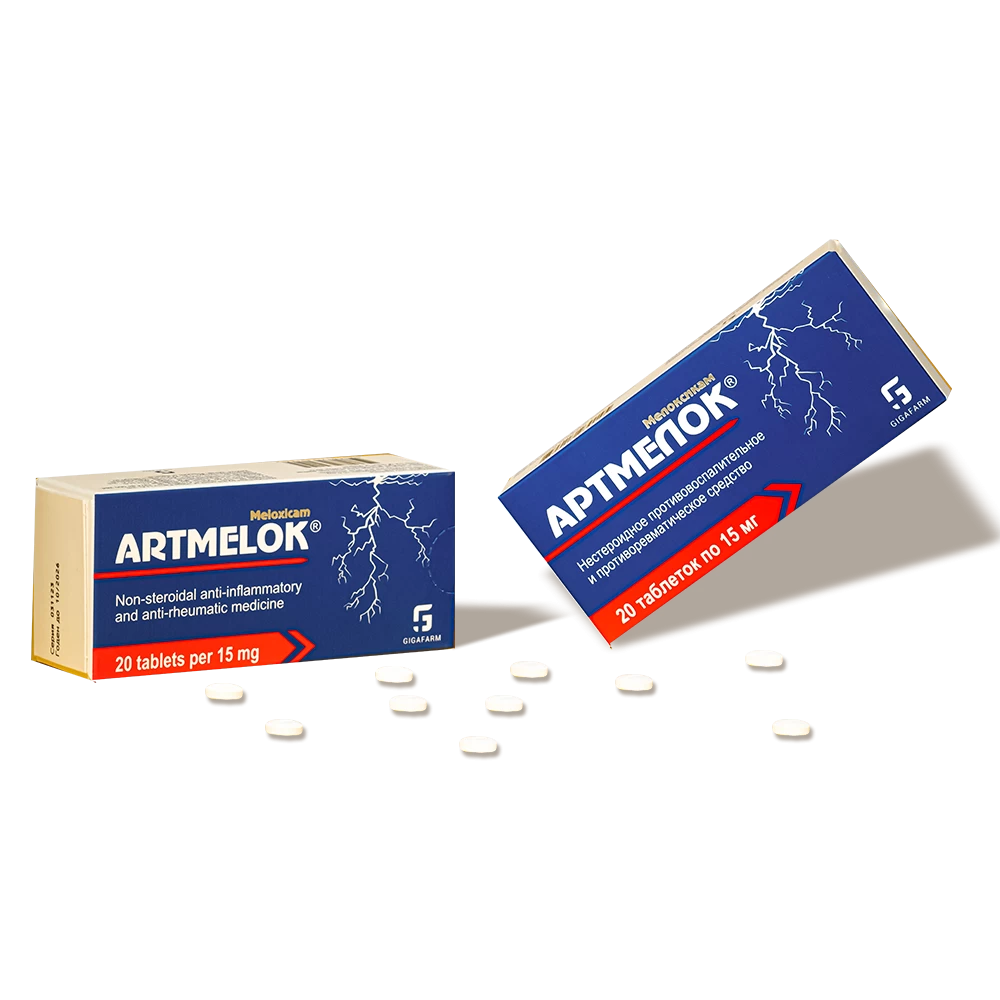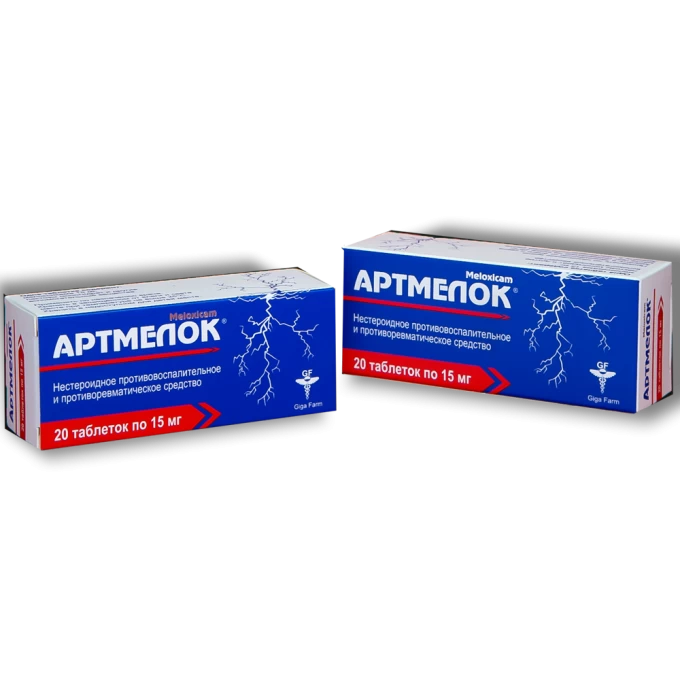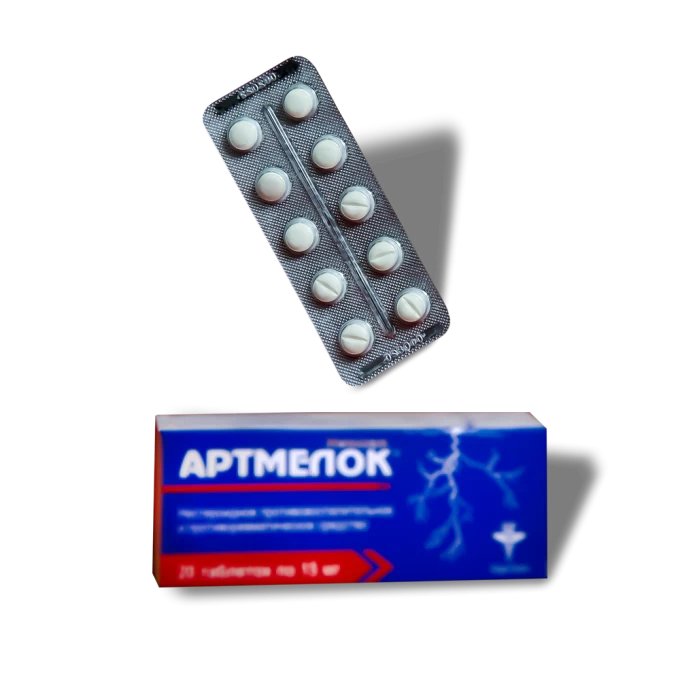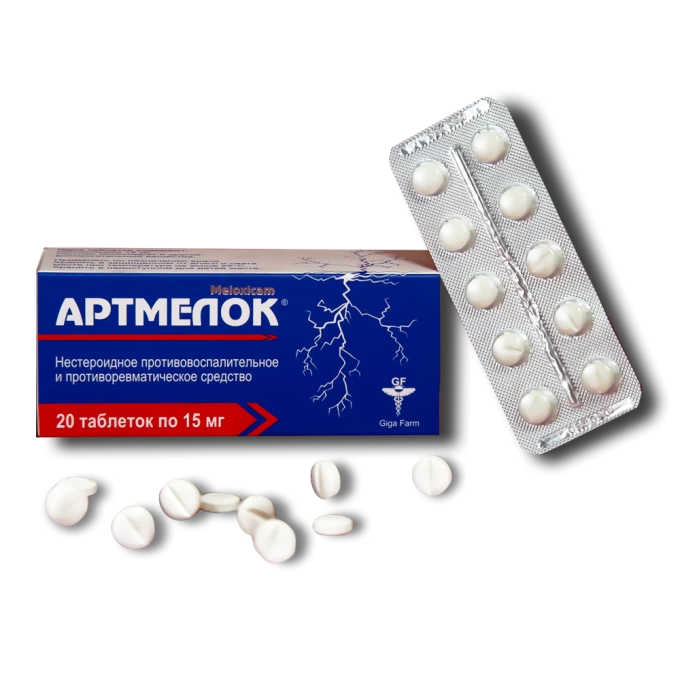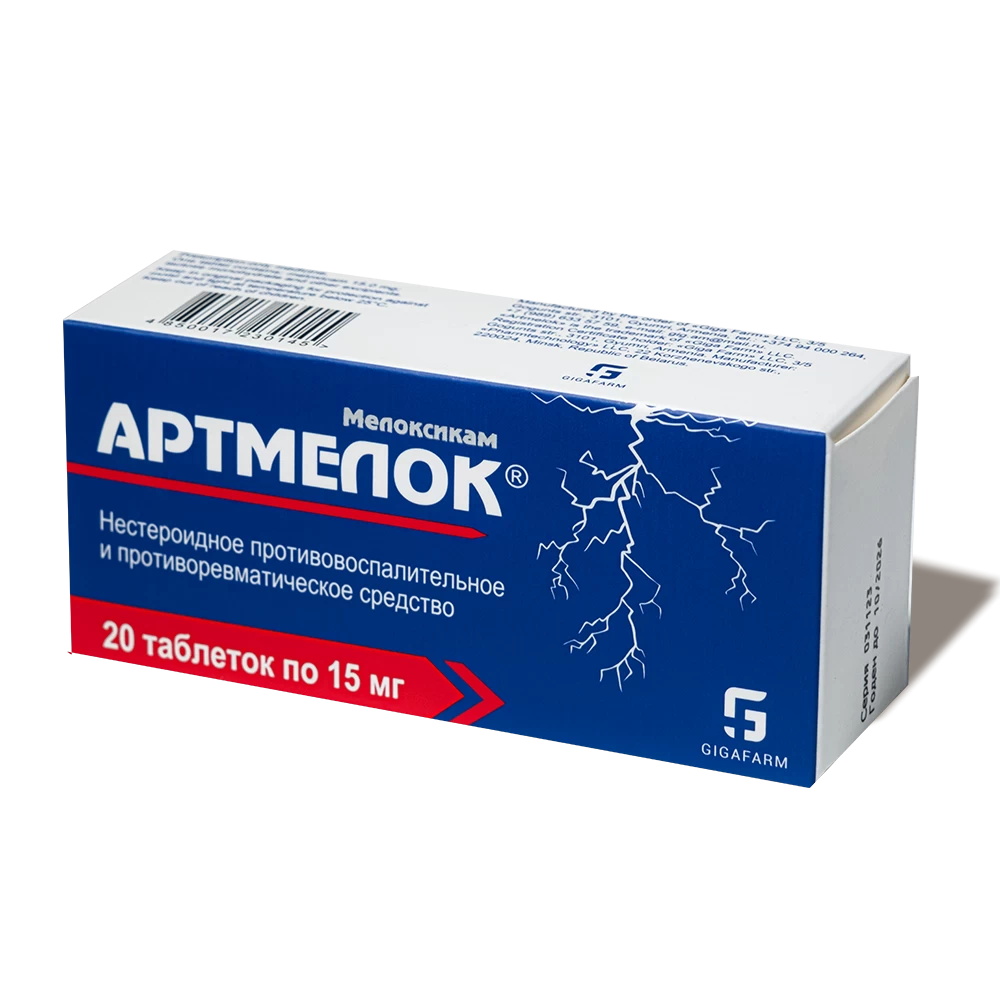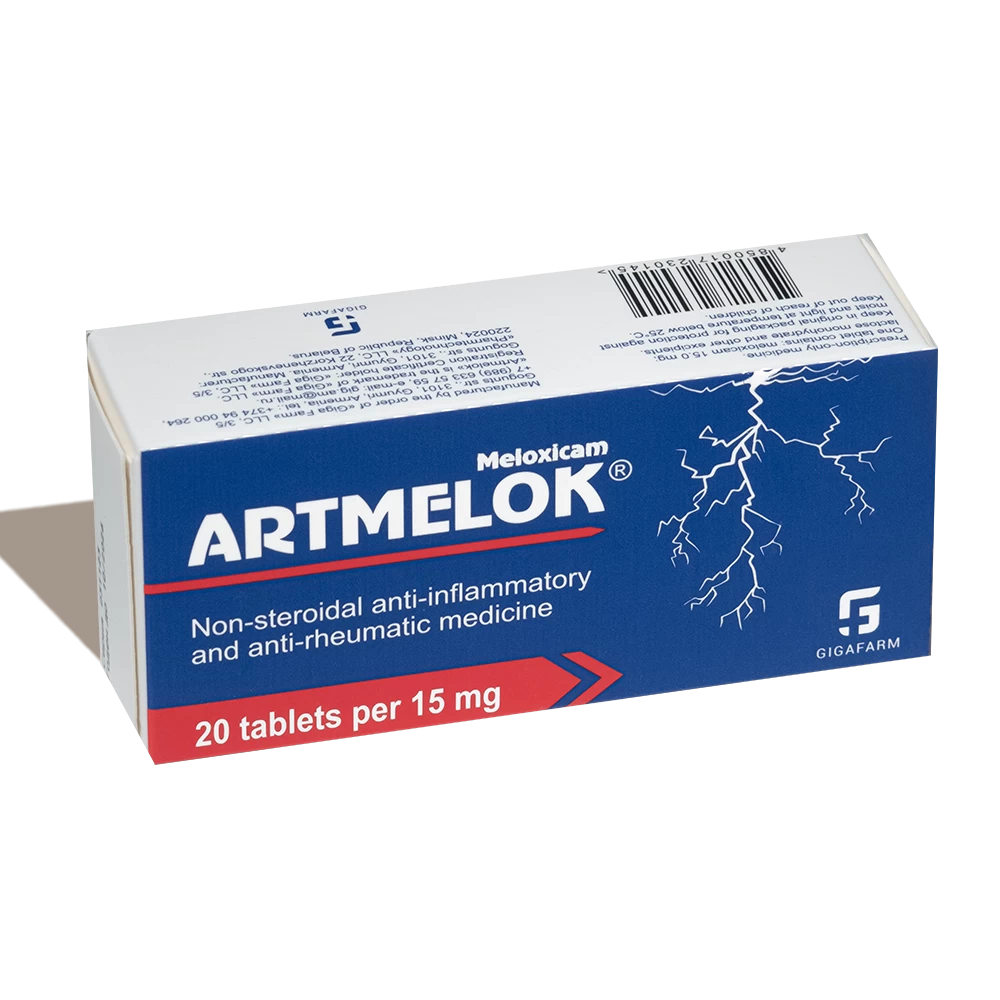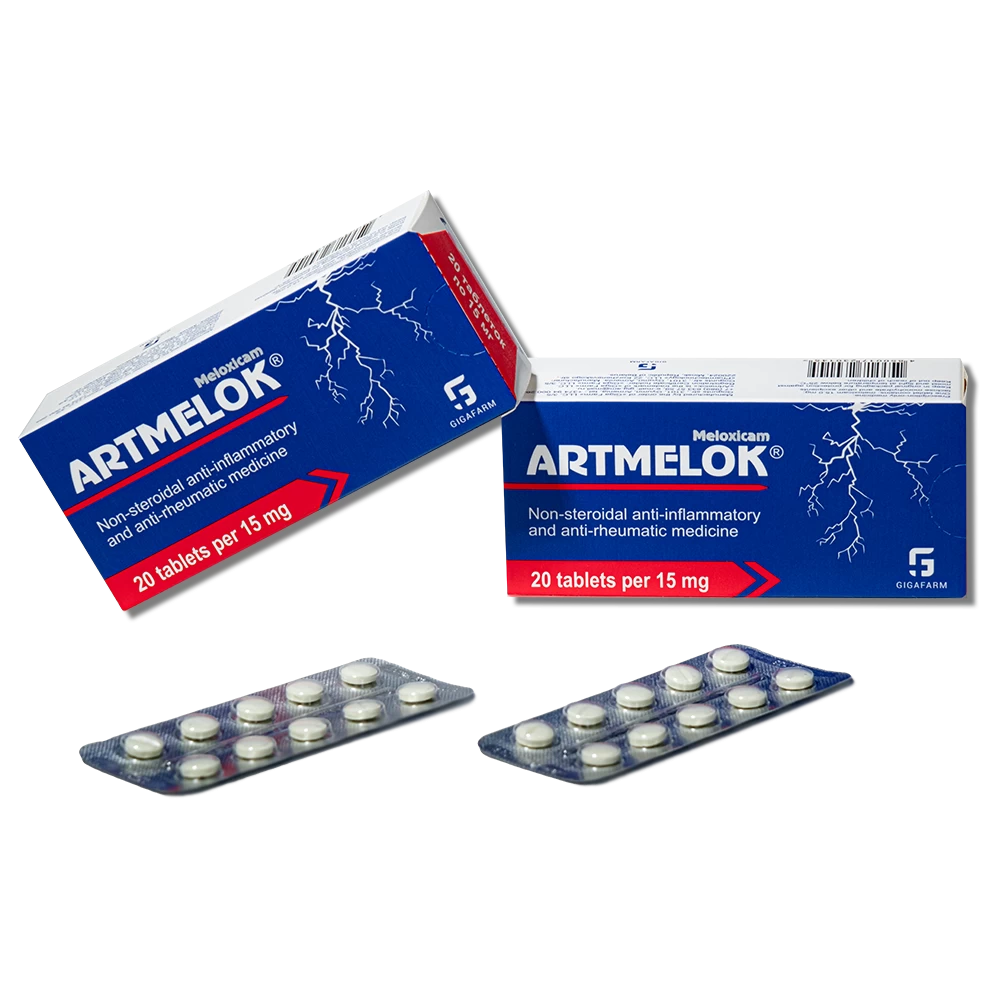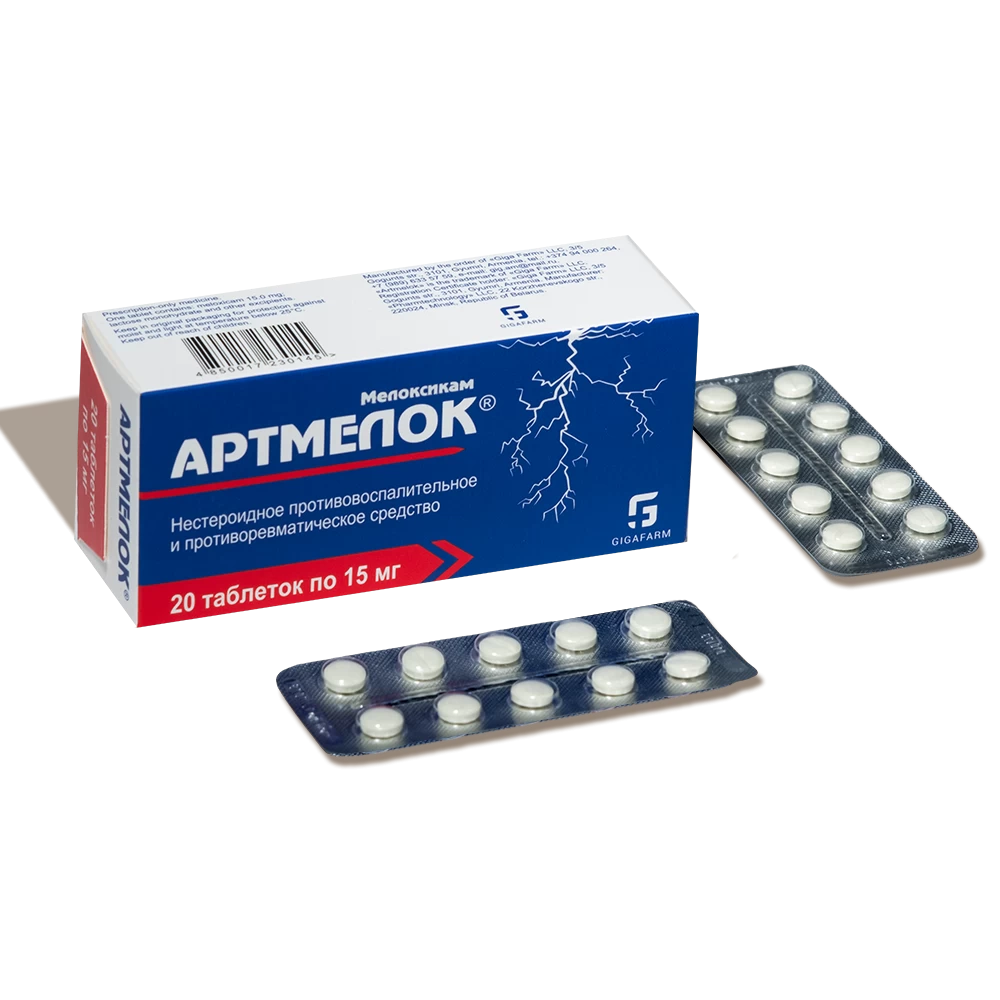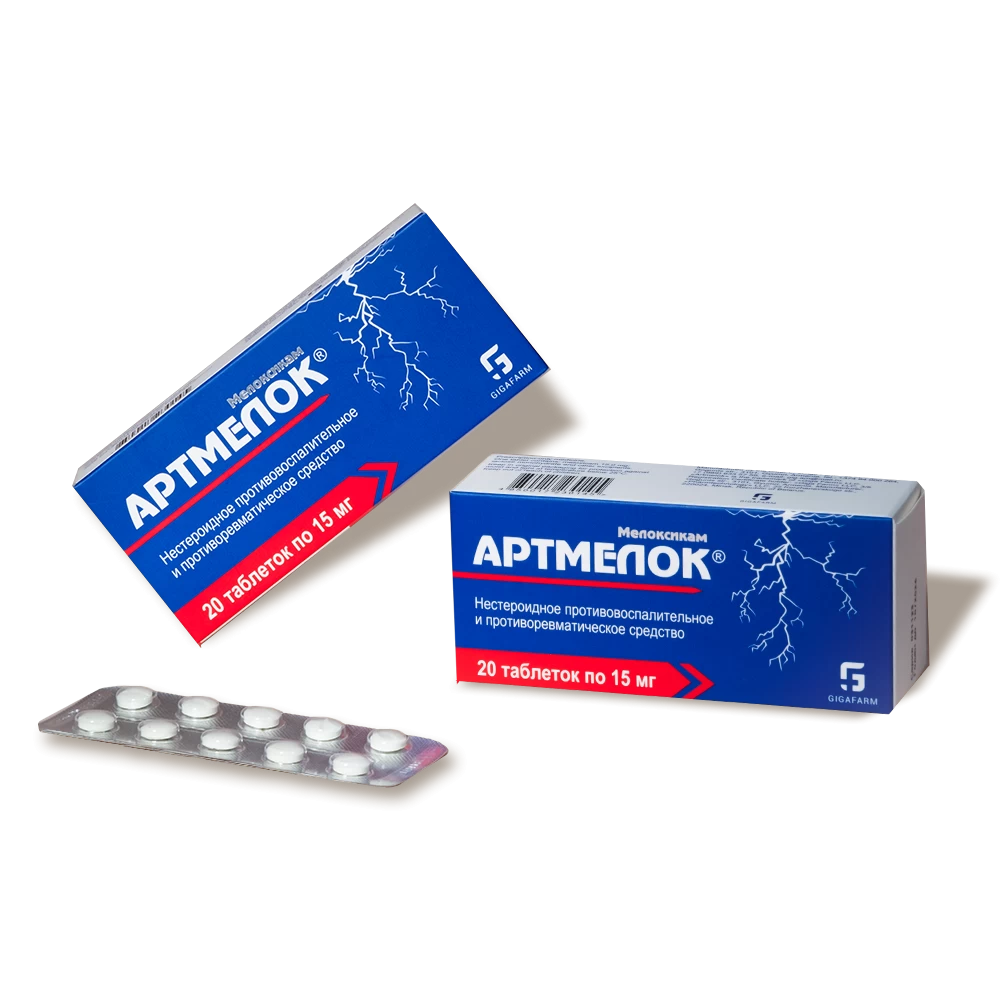Artmeloc 15mg N20
SHort description
Non-steroidal, anti-inflammatory and antirheumatic drug Ingredients: 15 mg meloxicam. Indications for use: symptomatic short-term treatment of activated arthrosis; symptomatic long-term treatment of rheumatoid arthritis (chronic polyarthritis) or ankylosing spondylitis (Bakhterev's disease). Dosage and administration: Activated arthrosis: the dose is 7.5 mg per day. In the absence of a therapeutic effect, this dose may be increased to 15 mg per day. Rheumatoid arthritis and ankylosing spondylitis: the dose is 15 mg per day. Depending on the therapeutic effect, this dose can be reduced to 7.5 mg per day.
Share
-
Description products
Artmelok
INSTRUCTIONS
According to the medical use of the drug
ARTMELOK®
International non-proprietary name name: Meloxicam.
Dosage form and its description: round biconvex tablets of light yellow color with a possible presence of marbling .
Composition: each tablet contains 15 mg of meloxicam as an active substance.
Excipients: lactose monohydrate, microcrystalline cellulose, corn starch, sodium starch glycolate (type A), magnesium stearate, anhydrous colloidal silicon dioxide.
Pharmacotherapeutic group: non-steroidal anti-inflammatory and antirheumatic drugs.
ATC code: M01AC06
Pharmacological properties.
Pharmacodynamics. ARTMELOK® is a non-steroidal anti-inflammatory drug (NSAID), belongs to enolic acid derivatives, has anti-inflammatory, analgesic and antipyretic effects. The expressed anti-inflammatory effect of meloxicam has been set on all the standard models of inflammation. The mechanism of action of meloxicam is its ability to inhibit the synthesis of prostaglandins, the known inflammatory mediators.
In vivo, meloxicam inhibits the synthesis of prostaglandins at the site of inflammation to a greater extent than in the gastric mucosa or in kidneys.
These differences are associated with more selective inhibition of cyclooxygenase-2 (COX-2) as compared to cyclooxygenase-1 (COX-1). It is believed that inhibition COX-2 provides the therapeutic effect of NSAID, while the inhibition of the constantly present isoenzyme COX-1 can cause side effects from the stomach and kidneys.
The selectivity of meloxicam as regards COX-2 has been confirmed in various test systems, both in vitro and in vivo. The selective ability of meloxicam to inhibit COX-2 has been shown when used as a test system of the human whole blood in vitro. In vivo, it has been set that meloxicam inhibited COX-2 more actively, exerting a greater inhibitory effect on the production of prostaglandin E2 stimulated by lipopolysaccharide (COX-2 controlled reaction) than on the production of thromboxane participating in blood coagulation process (COX-1 controlled reaction). These effects depended on the amount of dose. It has been shown in vivo that meloxicam in the recommended doses did not have influence on the aggregation of platelets and bleeding time, unlike indomethacin, diclofenac, ibuprofen and naproxen, which significantly suppressed the aggregation of platelets and increased bleeding time.
In clinical studies, gastrointestinal (GI) side effects have been generally less common in case of the usage of meloxicam than in case of the usage of other NSAIDs, which which comparison was conducted. This difference in the frequency of the gastrointestinal tract side effects is mainly connected with the fact that when taking meloxicam, such phenomena as dyspepsia, vomiting, nausea and abdominal pain were less common.
Pharmacokinetics.
Meloxicam is well absorbed from the gastrointestinal tract, as evidenced by its high absolute bioavailability when taken orally (89%).
When taking a single dosage of the drug in the form of tablets, the average maximum plasma concentration is reached within 5-6 hours. In case of repeated usage, a steady state of pharmacokinetics is achieved in a period of 3 to 5 days.
The range of differences between the maximum (Cmax) and basal concentrations (Cmin) of the drug during the steady state of pharmacokinetics after taking it once a day is relatively small and makes 0.8-2.0 μkg / ml. The maximum plasma concentration during the steady state of pharmacokinetics when taking the tablets is reached within 5-6 hours.
The concentrations of meloxicam after permanent usage of the drug for more than 1 year are similar to the concentrations observed after the first achievement of the stable state of pharmacokinetics.
The simultaneous food intake does not affect the absorption of meloxicam.
Meloxicam is connected well with the plasma proteins (with albumins - 99%). Meloxicam penetrates into the synovial fluid; the local concentrations make approximately 50% of plasma concentrations. The volume of distribution is low, in average making 11 liters. Individual fluctuations are 30-40%.
Meloxicam is almost completely metabolized in the liver with the formation of 4 pharmacologically inactive derivatives. The main metabolite, 5'-carboxymeloxicam (60% of the dose amount), is formed by oxidation of the intermediate metabolite, 5'-hydroxymethylmeloxicam, which is also excreted, but to a lesser extent (9% of the dose amount). In vitro studies have shown that CYP 2C9 plays an important role in the given metabolic transformation, and the CYP 3A4 isoenzyme has an additional importance. Peroxidase participates in the formation of two other metabolites (constituting, respectively, 16% and 4% of the dose amount of the drug), whose activity probably varies individually.
Meloxicam is removed equally with feces and urine, mainly in view of metabolites. Less than 5% of the amount of daily dose is removed unchanged with feces; the drug is found in the urine unchanged only in trace amounts. The average period of half-removal of meloxicam makes 20 hours.
Plasma clearance makes in average 8 ml/min. Meloxicam shows linear pharmacokinetics in doses of 7.5-15 mg when taken orally.
The failure of liver function, as well as mild or moderate kidney failure, does not significantly affect the pharmacokinetics of meloxicam. In case of temrinal kidney failure the increase of the volume of distribution may lead to higher concentrations of free meloxicam, that's why in these patients the daily dose should not exceed 7.5 mg.
In elderly patients, the average plasma clearance during the stable state of pharmacokinetics is slightly lower than in younger patients.
Indications for use:
· symptomatic short-term treatment of activated arthrosis;
· symptomatic long-term treatment of rheumatoid arthritis (chronic polyarthritis) or ankylosing spondylitis (Bekhterev's disease).
Dosage and administration
The drug ARTMELOK® is used orally.
The daily dose is appointed as a single dose with a glass of water or other liquid during meals. When using the lowest effective dose of the drug controlling the symptoms of the disease for a short period of time, the expressiveness of the side effect may be minimum. The therapeutic effectiveness and safety of the given drug should be regularly monitored, in particular, in patients with activated arthrosis.
Activated arthrosis: the dose makes 7.5 mg (half a tablet of 15 mg) per day. In the absence of a therapeutic effect, this dose may be increased up to 15 mg per day (one tablet of 15 mg)
Rheumatoid arthritis and ankylosing spondyloarthritis: the dose makes 15 mg (one 15 mg tablet) per day. Depending on the therapeutic effect, this dose can be reduced to 7.5 mg (half a tablet of 15 mg) per day.
THE DAILY DOSE OF 15 MG ARTMELOK® SHOULD NOT BE EXCEEDED.
Special patient groups:
Elderly patients and patients with an increased risk of side reactions: the daily dose of meloxicam should not exceed 7.5 mg at elderly patients in case of long-term treatment of rheumatoid arthritis or ankylosing spondyloarthritis, as well as at patients with an increased risk of side reactions.
Patients with limitation of kidney function: the daily dose of meloxicam should not exceed 7.5 mg at patients with severe kidney failure being at hemodialysis, dose reduction is not required at patients with light or moderate limitation of kidney function (creatinine clearance is at least 25 ml / min).
Patients with limitation of liver function: no dose reduction is required at patients with light or moderate limitation of liver function.
Children and young people: Meloxicam is contraindicated for children and young people under 16.
Side effect
From the gastrointestinal tract:> 1% - dyspepsia, nausea, vomiting, abdominal pain, constipation, flatulence, diarrhea; 0.1% -1% - transient changes in liver function indices (for example, increase of activity of transaminases or bilirubin), belching, esophagitis, gastroduodenal ulcer, hidden or overt gastrointestinal bleeding, stomatitis; < 0.1% - Gastrointestinal perforation, colitis, hepatitis, gastritis, gastrointestinal bleeding, erosive and ulcerative lesions and gastrointestinal perforation can potentially lead to life-threatening states.
Hematological: > 1% - anemia; 0.1% -1% - a change in the blood formula, including a change in the leukocyte formula, leukopenia and thrombocytopenia. A predisposing factor for the occurrence of cytopenia is the simultaneous use of potentially myelotoxic drugs, in particular, methotrexate.
Dermatological:> 1% - itching, skin rash; 0.1% -1% - urticaria; <0.1% - photosensitivity. In rare cases, the development of bullous reactions, erythema multiforme, Stevens-Johnson syndrome, toxic epidermal necrolysis is possible.
From the respiratory organs: <0.1% - at predisposed patients after the appointment of aspirin or other NSAIDs, including meloxicam, it was reported about the acute development of bronchial asthma.
From the central nervous system:> 1% - nausea, headache; 0.1% -1% - dizziness, tinnitus, drowsiness; < 0.1% - confusion, disorientation, mood changes.
From the cardiovascular system: > 1% - edema; 0.1% -1% - the increase of blood pressure, palpitations, a feeling of blood rush to the face.
From the genitourinary system: 0.1% -1% - changes in indicators of kidney function (increase of level of creatinine and / or urea in the blood serum); <0.1% - acute kidney failure, when using NSAIDs interstitial nephritis, albuminuria and hematuria may occur, but the relationship of these changes with the use of meloxicam has not been set yet.
From eye: <0.1% - conjunctivitis, eye problems, including blurred vision.
Hypersensitivity reactions: <0.1% - angioedema and immediate type hypersensitivity reactions, including anaphylactoid/anaphylactic reactions.
Contraindications
· Known hypersensitivity to meloxicam or any component of the ready dosage form. There is a possibility of cross-sensitivity to acetylsalicylic acid and other NSAIDs. The drug should not be prescribed to patients who have previously experienced symptoms of bronchial asthma, nasal polyposis, angioedema or urticaria after the usage of acetylsalicylic acid or other NSAIDs.
· Peptic ulcer of the stomach and duodenum in the acute phase.
· Gastrointestinal bleeding or perforation in anamnesis in connection with the previous NSAID therapy.
· Existing or available in anamnesis peptic ulcers or hemorrhages (at least 2 different episodes of confirmed ulceration or bleeding).
· Gastrointestinal bleeding, cerebrobleeding in the past, or other increased tendency to bleed.
· Severe liver function failure.
· Severe kidney failure (if hemodialysis is not performed).
· Overt gastrointestinal bleeding, recent cerebrovascular bleeding, or other bleeding
· Severe uncontrolled heart failure
· Children and young people under 16.
· Pregnancy or lactation.
Pregnancy and lactation
Meloxicam is contraindicated during pregnancy. The suppression of prostaglandins synthesis may have an undesirable effect on pregnancy and fetal development. The data of epidemiological studies indicate an the increase of risk of spontaneous abortions and heart defects in the fetus after the use of prostaglandin synthesis inhibitors during pregnancy. The absolute risk of the development of heart defects increased from less than 1% to 1.5%. Such a risk increases with the increase of dose and duration of therapy.
In the III trimester of pregnancy, the use of prostaglandin synthesis inhibitors may lead to the following fetal developmental disorders:
· The premature closure of the ductus arteriosus and pulmonary hypertension as a result of the toxic effects on the cardiopulmonary system;
· Kidney dysfunction, with the further development of kidney failure with a decrease in the amount of amniotic fluid.
The duration of bleeding may increase and the contractility of the uterus may decrease during childbirth, and as a result, the time of childbirth increases.
It is known that NSAIDs penetrate into breast milk, so meloxicam is not recommended for use during breastfeeding.
Overdose
The antidote is not known. In case of an overdose of the drug, gastric lavage and general supportive therapy should be carried out. Clinical studies have shown that cholestyramine accelerates the elimination of meloxicam.
Interaction with other drugs
Other NSAIDs, including salicylates (acetylsalicylic acid): the simultaneous use of more than one NSAID increases the risk of ulceration in the gastrointestinal tract and gastrointestinal bleeding as a result of the synergistic action. The combined use of meloxicam and other NSAIDs is not recommended. The combined use of aspirin (1000 mg 3 times a day) and meloxicam at healthy volunteers led to an increase in AUC (10%) and Cmax (24%) of meloxicam. The clinical significance of this interaction is not known.
Oral anticoagulants, antiplatelet agents, heparin for systemic usage, thrombolytic agents: an increase of the risk of bleeding. If it is impossible to avoid the simultaneous use of these drugs, careful monitoring of the effect of anticoagulants is necessary.
Lithium. NSAIDs increase the concentration of lithium in plasma by reducing the renal excretion of lithium. The concentration of lithium in plasma may reach toxic values. The combined use of lithium and NSAIDs is not recommended. If such combination therapy is necessary, the plasma lithium concentration should be monitored at the beginning of treatment, when selecting a dose and canceling meloxicam.
Methotrexate. NSAIDs can reduce tubular secretion of methotrexate and thus increase the concentration of methotrexate in plasma In this regard, patients receiving high doses of methotrexate (more than 15 mg per week), the simultaneous use of NSAIDs is not recommended. The risk of interaction with the simultaneous use of methotrexate and NSAIDs is also possible at patients receiving low doses of methotrexate, especially at patients with failure of kidney function. If combination therapy is necessary, the blood formula and kidney function should be monitored. Care should be taken if NSAIDs and methotrexate are used simultaneously for 3 days, because methotrexate concentration in plasma may increase and, as a result, toxic effects may occur. The simultaneous use of meloxicam did not affect the pharmacokinetics of methotrexate at a dose of 15 mg per week, however, it should be taken into account that the hematological toxicity of methotrexate increases when taken simultaneously with NSAIDs.
Contraception. Previously it was reported about the decrease of the effectiveness of intrauterine contraceptive devices in case of the usage of NSAIDs. This observation requires further confirmation.
Diuretics. The use of NSAIDs increases the risk of the development of acute kidney failure at dehydrated patients. The patients receiving meloxicam and diuretics should be adequately hydrated. The study of kidney function is necessary before starting the treatment.
Antihypertensive agents (for example, beta-blockers, angiotensin-converting enzyme (ACE) inhibitors, vasodilators, diuretics). NSAIDs reduce the effect of antihypertensive agents as a result of the inhibition of prostaglandins, which have vasodilating properties.
The combined use of NSAIDs and angiotensin II receptor antagonists (as well as ACE inhibitors) enhances the effect of reducing glomerular filtration. At patients with the disorder of kidney failure function, this may lead to the development of acute kidney failure.
Cholestyramine, by connecting meloxicam in the gastrointestinal tract, leads to its faster excretion.
NSAIDs, by affecting the renal prostaglandins, may increase the nephrotoxicity of cyclosporine. The function of kidneys should be monitored in case of the conduction of combination therapy.
Meloxicam is excreted from the body mainly through liver metabolism, about 2/3 of the amount of the drug metabolized in the liver is destroyed by the enzymes of the cytochrome system P-450 (the main metabolic pathway is cytochrome 2C9, the additional one is cytochrome 3A4), about 1/3 is metabolized by other systems, for example, through peroxidation. When used together with meloxicam drugs that have a known ability to inhibit CYP 2C9 and / or CYP 3A4 (or are metabolized with the participation of these enzymes), the possibility of pharmacokinetic interaction should be taken into account.
In case of the simultaneous use of meloxicam and antacids, cimetidine, digoxin or furosemide, no significant pharmacokinetic interactions were identified.
The possibility of interaction with oral antidiabetic agents cannot be excluded.
Precautionary measures
Caution should be exercised (like in case of the usage with other NSAIDs) when treating the patients with diseases of gastrointestinal tract in anamnesis and the patients receiving anticoagulants. The patients having gastrointestinal tract symptoms should be monitored regularly. If an ulcerative lesion of the gastrointestinal tract or gastrointestinal bleeding occurs, the usage of ARTMELOK® should be stopped.
Like in case of the usage of other NSAIDs, potentially patients' life-threatening gastrointestinal bleeding, ulcers and perforations may occur at any time during treatment, both in case of the presence of warning symptoms or information about serious gastrointestinal complications in anamnesis and in case of the absence of these features. The consequences of these complications are generally more serious for the elderly.
Particular attention should be paid to the patients reporting about the development of unwilling phenomenon from skin and mucous membranes. In such cases, the issue on the stoppage of the use of ARTMELOK® should be considered.
NSAIDs inhibit the synthesis of prostaglandins in the kidneys, which participate in maintaining renal perfusion. The use of NSAIDs at patients with a reduced renal blood flow or a reduced volume of circulating blood may lead to the decompensation of latent kidney failure. After the stoppage of NSAIDs, kidney function is usually restored to the initial level. Elderly patients are most subjected to the risk of development of this reaction; patients with dehydration, congestive heart failure, cirrhosis of the liver, nephrotic syndrome, or overt kidney diseases; patients receiving diuretics, ACE inhibitors, angiotensin II receptor antagonists, as well as patients who have undergone serious surgical interventions leading to hypovolemia. Diuresis and kidney function should be carefully monitored at the beginning of therapy in case of such patients.
In rare cases, NSAIDs can cause interstitial nephritis, glomerulonephritis, medullary renal necrosis, or nephrotic syndrome.
The dose of ARTMELOK® should not exceed 7.5 mg at patients with the terminal stage of kidney failure being on hemodialysis. The dose reduction is not required at patients with light or moderate disorders of kidney functions (i.e., if creatinine clearance is greater than 25 ml / min).
When using the drug ARTMELOK® (as well as most other NSAIDs), an occasional increase in the level of transaminases or other indicators of liver function in the blood serum has been reported. In most cases, this increase was small and transient. If the identified changes are significant or are not decreased over time, the use of ARTMELOK® should be stopped and the exposed laboratory changes should be monitored.
The drug dose reduction is not required at patients with clinically stable liver cirrhosis.
Debilitated or malnourished patients may be less able to tolerate unwilling phenomena, so such patients should be carefully monitored. Caution (as in the case of the use of other NSAIDs) should be observed in case of the treatment of elderly patients, who are more likely to have disorders of functions of kidney, liver and heart.
The use of NSAIDs in conjunction with diuretics may lead to retention of sodium, potassium and water, and have an influence on the natriuretic effect of diuretics. As a result, the signs of heart failure or hypertension may be increased at predisposed patients.
Meloxicam, like other NSAIDs, may mask the symptoms of an infectious disease.
The use of meloxicam, as well as other drugs blocking cyclooxygenase / prostaglandin synthesis, can affect fertility, so it is not recommended for women who want to become pregnant. In case of violation of an ability to conceive at women or the conduction of an examination for infertility, it is necessary to consider an issue on the stoppage of meloxicam.
When carrying out therapy with meloxicam, monitoring and consultation of patients with arterial hypertension and / or heart failure (from light to decompensated) in anamnesis is required, since it has been reported about the possibility of fluid inclusion in cells and the occurrence of edema during therapy with NSAIDs. Clinical blood pressure monitoring is recommended for at-risk patients before and immediately after the usage of meloxicam. Clinical studies and epidemiological data suggest that the use of some NSAIDs, including meloxicam, especially at high doses and in long-term period, is associated with the risk of arterial thrombotic complications (for example, myocardial infarction, stroke). For meloxicam, such a risk has not been excluded up to now. The decision to prescribe meloxicam to patients with high blood pressure, heart failure, existing coronary heart disease and cerebrovascular disease should be made only after careful weighing of all the risks and benefits for the patient. The same approach should be also taken before long-term treatment with meloxicam to patients with risk factors of cardiovascular diseases (efor example, high blood pressure, dyslipidaemia, diabetes, smoking).
Effect on ability to drive and other machines
Special studies on the effect of meloxicam on the ability to drive vehicles and mechanisms have not been conducted. This activity should be avoided by the patients with eye disorders, the patients having drowsiness or other disorders of the central nervous system.
Release form: 15 mg tablets in blisters No. 10x2. 2 blisters, together with instructions for use, are placed in cardboard packs.
Storage conditions
Store in a place protected from moisture and light at a temperature not exceeding 25°C.
Keep out of the reach of children.
Shelf - Life
2 years. The expiration date is indicated on the packaging. This drug must not be used after the date indicated on the package.
Legal status for supply
ARTMELOK® is released by prescription.
Manufacturer: «Pharmtechnology» LLC, the Republic of Belarus, 220024, c. Minsk, str. Korzhenevsky, 22.
By order of «Giga Pharm» LLC. Tel. +37494000264. E-mail: gig.am@mail.ru
-
Video
Artmelok
INSTRUCTIONS
According to the medical use of the drug
ARTMELOK®
International non-proprietary
name name:
Meloxicam.
Dosage form and its description: round biconvex tablets of light yellow
color with a possible presence of marbling .
Composition: each tablet contains 15 mg of meloxicam as an active
substance.
Excipients: lactose monohydrate, microcrystalline cellulose, corn
starch, sodium starch glycolate (type A), magnesium stearate, anhydrous
colloidal silicon dioxide.
Pharmacotherapeutic group: non-steroidal
anti-inflammatory and antirheumatic drugs.
ATC code: M01AC06
Pharmacological properties.
Pharmacodynamics. ARTMELOK® is a non-steroidal
anti-inflammatory drug (NSAID), belongs to enolic acid derivatives, has
anti-inflammatory, analgesic and antipyretic effects. The expressed anti-inflammatory
effect of meloxicam has been set on all the standard models of inflammation.
The mechanism of action of meloxicam is its ability to inhibit the synthesis of
prostaglandins, the known inflammatory mediators.
In vivo, meloxicam inhibits the synthesis of
prostaglandins at the site of inflammation to a greater extent than in the
gastric mucosa or in kidneys.
These differences are associated with more selective
inhibition of cyclooxygenase-2 (COX-2) as compared to cyclooxygenase-1 (COX-1).
It is believed that inhibition COX-2 provides the therapeutic effect of NSAID,
while the inhibition of the constantly present isoenzyme COX-1 can cause side
effects from the stomach and kidneys.
The selectivity of meloxicam as regards COX-2 has been
confirmed in various test systems, both in vitro and in vivo. The selective
ability of meloxicam to inhibit COX-2 has been shown when used as a test system
of the human whole blood in vitro. In vivo, it has been set that meloxicam
inhibited COX-2 more actively, exerting a greater inhibitory effect on the
production of prostaglandin E2 stimulated by lipopolysaccharide (COX-2
controlled reaction) than on the production of thromboxane participating in
blood coagulation process (COX-1 controlled reaction). These effects depended
on the amount of dose. It has been shown in vivo that meloxicam in the recommended
doses did not have influence on the aggregation of platelets and bleeding time,
unlike indomethacin, diclofenac, ibuprofen and naproxen, which significantly
suppressed the aggregation of platelets and increased bleeding time.
In clinical studies, gastrointestinal (GI) side effects have
been generally less common in case of the usage of meloxicam than in case of
the usage of other NSAIDs, which which comparison was conducted. This
difference in the frequency of the gastrointestinal tract side effects is
mainly connected with the fact that when taking meloxicam, such phenomena as
dyspepsia, vomiting, nausea and abdominal pain were less common.
Pharmacokinetics.
Meloxicam is well absorbed from the gastrointestinal
tract, as evidenced by its high absolute bioavailability when taken orally
(89%).
When taking a single dosage of the drug in the form of
tablets, the average maximum plasma concentration is reached within 5-6 hours. In
case of repeated usage, a steady state of pharmacokinetics is achieved in a
period of 3 to 5 days.
The range of differences between the maximum (Cmax) and basal
concentrations (Cmin) of the drug during the steady state of pharmacokinetics
after taking it once a day is relatively small and makes 0.8-2.0 μkg / ml. The
maximum plasma concentration during the steady state of pharmacokinetics when
taking the tablets is reached within 5-6 hours.
The concentrations of meloxicam after permanent usage of
the drug for more than 1 year are similar to the concentrations observed after
the first achievement of the stable state of pharmacokinetics.
The simultaneous food intake does not affect the
absorption of meloxicam.
Meloxicam is connected well with the plasma proteins
(with albumins - 99%). Meloxicam penetrates into the synovial fluid; the local
concentrations make approximately 50% of plasma concentrations. The volume of
distribution is low, in average making 11 liters. Individual fluctuations are
30-40%.
Meloxicam is almost completely metabolized in the liver
with the formation of 4 pharmacologically inactive derivatives. The main
metabolite, 5'-carboxymeloxicam (60% of the dose amount), is formed by
oxidation of the intermediate metabolite, 5'-hydroxymethylmeloxicam, which is
also excreted, but to a lesser extent (9% of the dose amount). In vitro studies
have shown that CYP 2C9 plays an important role in the given metabolic
transformation, and the CYP 3A4 isoenzyme has an additional importance.
Peroxidase participates in the formation of two other metabolites
(constituting, respectively, 16% and 4% of the dose amount of the drug), whose
activity probably varies individually.
Meloxicam is removed equally with feces and urine, mainly
in view of metabolites. Less than 5% of the amount of daily dose is removed
unchanged with feces; the drug is found in the urine unchanged only in trace
amounts. The average period of half-removal of meloxicam makes 20 hours.
Plasma clearance makes in average 8 ml/min. Meloxicam
shows linear pharmacokinetics in doses of 7.5-15 mg when taken orally.
The failure of liver function, as well as mild or
moderate kidney failure, does not significantly affect the pharmacokinetics of
meloxicam. In case of temrinal kidney failure the increase of the volume of
distribution may lead to higher concentrations of free meloxicam, that's why in
these patients the daily dose should not exceed 7.5 mg.
In elderly patients, the average plasma clearance during
the stable state of pharmacokinetics is slightly lower than in younger
patients.
Indications for use:
·
symptomatic short-term treatment of activated arthrosis;
·
symptomatic long-term treatment of rheumatoid arthritis
(chronic polyarthritis) or ankylosing spondylitis (Bekhterev's disease).
Dosage and administration
The drug ARTMELOK® is used orally.
The daily dose is appointed as a single dose with a glass
of water or other liquid during meals. When using the lowest effective dose of the
drug controlling the symptoms of the disease for a short period of time, the expressiveness
of the side effect may be minimum. The therapeutic effectiveness and safety of
the given drug should be regularly monitored, in particular, in patients with
activated arthrosis.
Activated arthrosis: the dose makes 7.5 mg (half a tablet
of 15 mg) per day. In the absence of a therapeutic effect, this dose may be
increased up to 15 mg per day (one tablet of 15 mg)
Rheumatoid arthritis and ankylosing spondyloarthritis: the dose makes
15 mg (one 15 mg tablet) per day. Depending on the therapeutic effect, this
dose can be reduced to 7.5 mg (half a tablet of 15 mg) per day.
THE DAILY DOSE OF 15 MG ARTMELOK® SHOULD NOT BE EXCEEDED.
Special patient groups:
Elderly patients and patients with an increased risk of
side reactions: the daily dose of meloxicam should not exceed 7.5 mg at
elderly patients in case of long-term treatment of rheumatoid arthritis or
ankylosing spondyloarthritis, as well as at patients with an increased risk of
side reactions.
Patients with limitation of kidney function: the daily dose of
meloxicam should not exceed 7.5 mg at patients with severe kidney failure being
at hemodialysis, dose reduction is not required at patients with light or
moderate limitation of kidney function (creatinine clearance is at least 25 ml
/ min).
Patients with limitation of liver function: no dose reduction
is required at patients with light or moderate limitation of liver function.
Children and young people: Meloxicam is
contraindicated for children and young people under 16.
Side effect
From the gastrointestinal tract:> 1% -
dyspepsia, nausea, vomiting, abdominal pain, constipation, flatulence,
diarrhea; 0.1% -1% - transient changes in liver function indices (for example,
increase of activity of transaminases or bilirubin), belching, esophagitis,
gastroduodenal ulcer, hidden or overt gastrointestinal bleeding, stomatitis;
< 0.1% - Gastrointestinal perforation, colitis, hepatitis, gastritis,
gastrointestinal bleeding, erosive and ulcerative lesions and gastrointestinal
perforation can potentially lead to life-threatening states.
Hematological: > 1% - anemia; 0.1% -1% - a change in the blood formula,
including a change in the leukocyte formula, leukopenia and thrombocytopenia. A
predisposing factor for the occurrence of cytopenia is the simultaneous use of potentially
myelotoxic drugs, in particular, methotrexate.
Dermatological:> 1% - itching, skin rash; 0.1% -1% - urticaria;
<0.1% - photosensitivity. In rare cases, the development of bullous
reactions, erythema multiforme, Stevens-Johnson syndrome, toxic epidermal
necrolysis is possible.
From the respiratory organs: <0.1% - at
predisposed patients after the appointment of aspirin or other NSAIDs,
including meloxicam, it was reported about the acute development of bronchial
asthma.
From the central nervous system:> 1% - nausea,
headache; 0.1% -1% - dizziness, tinnitus, drowsiness; < 0.1% - confusion,
disorientation, mood changes.
From the cardiovascular system: > 1% - edema;
0.1% -1% - the increase of blood
pressure, palpitations, a feeling of blood rush to the face.
From the genitourinary system: 0.1% -1% -
changes in indicators of kidney function (increase of level of creatinine and /
or urea in the blood serum); <0.1% - acute kidney failure, when using NSAIDs
interstitial nephritis, albuminuria and hematuria may occur, but the
relationship of these changes with the use of meloxicam has not been set yet.
From eye: <0.1% - conjunctivitis, eye problems, including
blurred vision.
Hypersensitivity reactions: <0.1% -
angioedema and immediate type hypersensitivity reactions, including
anaphylactoid/anaphylactic reactions.
Contraindications
·
Known hypersensitivity to meloxicam or any component of
the ready dosage form. There is a possibility of cross-sensitivity to
acetylsalicylic acid and other NSAIDs. The drug should not be prescribed to
patients who have previously experienced symptoms of bronchial asthma, nasal
polyposis, angioedema or urticaria after the usage of acetylsalicylic acid or
other NSAIDs.
·
Peptic ulcer of the stomach and duodenum in the acute
phase.
·
Gastrointestinal bleeding or perforation in anamnesis in connection with the previous NSAID therapy.
·
Existing or available in anamnesis peptic ulcers or
hemorrhages (at least 2 different episodes of confirmed ulceration or
bleeding).
·
Gastrointestinal bleeding, cerebrobleeding in the past,
or other increased tendency to bleed.
·
Severe liver function failure.
·
Severe kidney failure (if hemodialysis is not performed).
·
Overt gastrointestinal bleeding, recent cerebrovascular
bleeding, or other bleeding
·
Severe
uncontrolled heart failure
·
Children and young people under 16.
·
Pregnancy or lactation.
Pregnancy and lactation
Meloxicam is contraindicated during pregnancy. The
suppression of prostaglandins synthesis may have an undesirable effect on
pregnancy and fetal development. The data of epidemiological studies indicate
an the increase of risk of spontaneous abortions and heart defects in the fetus
after the use of prostaglandin synthesis inhibitors during pregnancy. The
absolute risk of the development of heart defects increased from less than 1%
to 1.5%. Such a risk increases with the increase of dose and duration of
therapy.
In the III
trimester of pregnancy, the use of prostaglandin synthesis inhibitors may lead
to the following fetal developmental disorders:
·
The premature closure of the ductus arteriosus and
pulmonary hypertension as a result of the toxic effects on the cardiopulmonary
system;
·
Kidney dysfunction, with the further development of
kidney failure with a decrease in the amount of amniotic fluid.
The duration of bleeding may increase and the contractility of the uterus
may decrease during childbirth, and as a result, the time of childbirth
increases.
It is known that NSAIDs penetrate into breast milk, so meloxicam is not
recommended for use during breastfeeding.
Overdose
The antidote is not known. In case of an overdose of the drug, gastric
lavage and general supportive therapy should be carried out. Clinical studies
have shown that cholestyramine accelerates the elimination of meloxicam.
Interaction with other drugs
Other NSAIDs, including salicylates (acetylsalicylic acid): the
simultaneous use of more than one NSAID increases the risk of ulceration in the
gastrointestinal tract and gastrointestinal bleeding as a result of the synergistic
action. The combined use of meloxicam and other NSAIDs is not recommended. The
combined use of aspirin (1000 mg 3 times a day) and meloxicam at healthy
volunteers led to an increase in AUC (10%) and Cmax (24%) of meloxicam. The
clinical significance of this interaction is not known.
Oral anticoagulants, antiplatelet agents, heparin for systemic
usage, thrombolytic agents: an increase of the risk of bleeding. If it is
impossible to avoid the simultaneous use of these drugs, careful monitoring of
the effect of anticoagulants is necessary.
Lithium. NSAIDs increase the concentration of lithium in plasma
by reducing the renal excretion of lithium. The concentration of lithium in
plasma may reach toxic values. The combined use of lithium and NSAIDs is not
recommended. If such combination therapy is necessary, the plasma lithium
concentration should be monitored at the beginning of treatment, when selecting
a dose and canceling meloxicam.
Methotrexate. NSAIDs can reduce
tubular secretion of methotrexate and thus increase the concentration of
methotrexate in plasma In this regard, patients receiving high doses of
methotrexate (more than 15 mg per week), the simultaneous use of NSAIDs is not
recommended. The risk of interaction with the simultaneous use of methotrexate
and NSAIDs is also possible at patients receiving low doses of methotrexate,
especially at patients with failure of kidney function. If combination therapy
is necessary, the blood formula and kidney function should be monitored. Care should
be taken if NSAIDs and methotrexate are used simultaneously for 3 days, because
methotrexate concentration in plasma may increase and, as a result, toxic
effects may occur. The simultaneous use of meloxicam did not affect the
pharmacokinetics of methotrexate at a dose of 15 mg per week, however, it
should be taken into account that the hematological toxicity of methotrexate
increases when taken simultaneously with NSAIDs.
Contraception. Previously it was
reported about the decrease of the effectiveness of intrauterine contraceptive
devices in case of the usage of NSAIDs. This observation requires further
confirmation.
Diuretics. The use of NSAIDs increases the risk of the development
of acute kidney failure at dehydrated patients. The patients receiving meloxicam
and diuretics should be adequately hydrated. The study of kidney function is
necessary before starting the treatment.
Antihypertensive agents (for example,
beta-blockers, angiotensin-converting enzyme (ACE) inhibitors, vasodilators,
diuretics). NSAIDs reduce the effect of antihypertensive agents as a result of
the inhibition of prostaglandins, which have vasodilating properties.
The combined use of NSAIDs and angiotensin II receptor antagonists (as
well as ACE inhibitors) enhances the effect of reducing glomerular filtration. At
patients with the disorder of kidney
failure function, this may lead to the development of acute kidney failure.
Cholestyramine, by connecting meloxicam in the gastrointestinal tract,
leads to its faster excretion.
NSAIDs, by affecting the renal prostaglandins, may increase the
nephrotoxicity of cyclosporine. The function of kidneys should be
monitored in case of the conduction of combination therapy.
Meloxicam is excreted from the body mainly through liver metabolism, about
2/3 of the amount of the drug metabolized in the liver is destroyed by the
enzymes of the cytochrome system P-450 (the main metabolic pathway is cytochrome
2C9, the additional one is cytochrome 3A4), about 1/3 is metabolized by other
systems, for example, through peroxidation. When used together with meloxicam
drugs that have a known ability to inhibit CYP 2C9 and / or CYP 3A4 (or are
metabolized with the participation of these enzymes), the possibility of
pharmacokinetic interaction should be taken into account.
In case of the simultaneous use of meloxicam and antacids, cimetidine,
digoxin or furosemide, no significant pharmacokinetic interactions were
identified.
The possibility of interaction with oral antidiabetic agents
cannot be excluded.
Precautionary measures
Caution should be exercised (like in case of the usage with other NSAIDs)
when treating the patients with diseases of gastrointestinal tract in anamnesis
and the patients receiving anticoagulants. The patients having gastrointestinal
tract symptoms should be monitored regularly. If an ulcerative lesion of the
gastrointestinal tract or gastrointestinal bleeding occurs, the usage of ARTMELOK®
should be stopped.
Like in case of the usage of other NSAIDs, potentially patients' life-threatening
gastrointestinal bleeding, ulcers and perforations may occur at any time during
treatment, both in case of the presence of warning symptoms or information
about serious gastrointestinal complications in anamnesis and in case of the
absence of these features. The consequences of these complications are
generally more serious for the elderly.
Particular attention should be paid to the patients reporting about the
development of unwilling phenomenon from skin and mucous membranes. In such
cases, the issue on the stoppage of the use of ARTMELOK® should be considered.
NSAIDs inhibit the synthesis of prostaglandins in the kidneys, which
participate in maintaining renal perfusion. The use of NSAIDs at patients with a reduced renal blood flow
or a reduced volume of circulating blood may lead to the decompensation of
latent kidney failure. After the stoppage of NSAIDs, kidney function is usually
restored to the initial level. Elderly patients are most subjected to the risk
of development of this reaction; patients with dehydration, congestive heart
failure, cirrhosis of the liver, nephrotic syndrome, or overt kidney diseases;
patients receiving diuretics, ACE inhibitors, angiotensin II receptor
antagonists, as well as patients who have undergone serious surgical
interventions leading to hypovolemia. Diuresis and kidney function should be
carefully monitored at the beginning of therapy in case of such patients.
In rare cases, NSAIDs can cause interstitial nephritis, glomerulonephritis,
medullary renal necrosis, or nephrotic syndrome.
The dose of ARTMELOK® should not exceed 7.5 mg at patients with the
terminal stage of kidney failure being on hemodialysis. The dose reduction is
not required at patients with light or moderate disorders of kidney functions (i.e.,
if creatinine clearance is greater than 25 ml / min).
When using the drug ARTMELOK® (as well as most other NSAIDs), an occasional
increase in the level of transaminases or other indicators of liver function in
the blood serum has been reported. In most cases, this increase was small and
transient. If the identified changes are significant or are not decreased over
time, the use of ARTMELOK® should be stopped and the exposed laboratory changes
should be monitored.
The drug dose reduction is not required at patients with clinically stable
liver cirrhosis.
Debilitated or malnourished patients may be less able to tolerate unwilling
phenomena, so such patients should be carefully monitored. Caution (as in the
case of the use of other NSAIDs) should be observed in case of the treatment of
elderly patients, who are more likely to have disorders of functions of kidney,
liver and heart.
The use of NSAIDs in conjunction with diuretics may lead to retention of
sodium, potassium and water, and have an influence on the natriuretic effect of
diuretics. As a result, the signs of heart failure or hypertension may be
increased at predisposed patients.
Meloxicam, like other NSAIDs, may mask the symptoms of an infectious
disease.
The use of meloxicam, as well as other drugs blocking cyclooxygenase /
prostaglandin synthesis, can affect fertility, so it is not recommended for
women who want to become pregnant. In case of violation of an ability to
conceive at women or the conduction of an examination for infertility, it is
necessary to consider an issue on the stoppage of meloxicam.
When carrying out therapy with meloxicam, monitoring and consultation of
patients with arterial hypertension and / or heart failure (from light to
decompensated) in anamnesis is required, since it has been reported about the
possibility of fluid inclusion in cells and the occurrence of edema during therapy
with NSAIDs. Clinical blood pressure monitoring is recommended for at-risk
patients before and immediately after the usage of meloxicam. Clinical studies
and epidemiological data suggest that the use of some NSAIDs, including
meloxicam, especially at high doses and in long-term period, is associated with
the risk of arterial thrombotic complications (for example, myocardial
infarction, stroke). For meloxicam, such a risk has not been excluded up to now.
The decision to prescribe meloxicam to patients with high blood pressure, heart
failure, existing coronary heart disease and cerebrovascular disease should be
made only after careful weighing of all the risks and benefits for the patient.
The same approach should be also taken before long-term treatment with
meloxicam to patients with risk factors of cardiovascular diseases (efor
example, high blood pressure, dyslipidaemia, diabetes, smoking).
Effect on ability to drive and other machines
Special studies on the effect of meloxicam on the ability to drive vehicles
and mechanisms have not been conducted. This activity should be avoided by the
patients with eye disorders, the patients having drowsiness or other disorders
of the central nervous system.
Release form: 15 mg tablets in blisters No. 10x2. 2 blisters,
together with instructions for use, are placed in cardboard packs.
Storage conditions
Store in a place protected from moisture and light at a temperature not
exceeding 25°C.
Keep out of the reach of children.
Shelf - Life
2 years. The expiration date is indicated on the packaging. This drug must
not be used after the date indicated on the package.
Legal status for supply
ARTMELOK® is released by prescription.
Manufacturer: «Pharmtechnology» LLC, the Republic of Belarus, 220024, c.
Minsk, str. Korzhenevsky, 22.
By order of «Giga Pharm»
LLC. Tel. +37494000264. E-mail: gig.am@mail.ru

